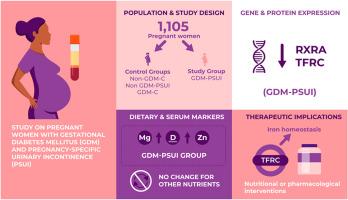Lower RXRA and TFRC expression despite higher mineral and vitamin intake in diabetic pregnant women with pregnancy-specific urinary incontinence
Q3 Nursing
引用次数: 0
Abstract
Background
Gestational diabetes mellitus (GDM) and pregnancy-specific urinary incontinence (PSUI) pose significant health challenges for pregnant women, but their metabolic and molecular underpinnings remain poorly understood.
Methods
In this cross-sectional study, 1,105 participants from the DIAMATER cohort were categorized based on GDM and PSUI status. Dietary intake of iron, magnesium, zinc, and vitamins A and D was assessed through dietary recalls, while serum levels, gene expression (MTF1, RXRA, TFRC, TRPM6), and protein expression were analyzed using standard techniques. Oxidative stress markers were also measured.
Results
GDM-PSUI participants exhibited lower RXRA and TFRC gene expression and decreased TFRC protein levels despite higher intake of magnesium, zinc, and vitamin D compared to GDM controls without PSUI. Serum mineral levels and oxidative stress markers did not differ significantly between groups.
Conclusions
Lower RXRA and TFRC expression in GDM-PSUI women, despite increased mineral and vitamin intake, suggests potential molecular targets for interventions aimed at improving management strategies in this population.

低RXRA和TFRC表达尽管较高的矿物质和维生素摄入在糖尿病孕妇妊娠特异性尿失禁
妊娠期糖尿病(GDM)和妊娠期尿失禁(PSUI)对孕妇的健康构成了重大挑战,但其代谢和分子基础尚不清楚。方法在这项横断面研究中,来自DIAMATER队列的1105名参与者根据GDM和PSUI状态进行分类。通过饮食回顾评估膳食中铁、镁、锌、维生素A和D的摄入量,同时使用标准技术分析血清水平、基因表达(MTF1、RXRA、TFRC、TRPM6)和蛋白质表达。氧化应激标志物也被测量。结果与没有PSUI的GDM对照组相比,GDM-PSUI参与者尽管摄入了更多的镁、锌和维生素D,但RXRA和TFRC基因表达较低,TFRC蛋白水平也较低。血清矿物质水平和氧化应激标志物组间无显著差异。结论GDM-PSUI女性尽管矿物质和维生素摄入量增加,但RXRA和TFRC表达较慢,这提示了改善该人群管理策略的潜在分子干预靶点。
本文章由计算机程序翻译,如有差异,请以英文原文为准。
求助全文
约1分钟内获得全文
求助全文
来源期刊

Clinical Nutrition Open Science
Nursing-Nutrition and Dietetics
CiteScore
2.20
自引率
0.00%
发文量
55
审稿时长
18 weeks
 求助内容:
求助内容: 应助结果提醒方式:
应助结果提醒方式:


